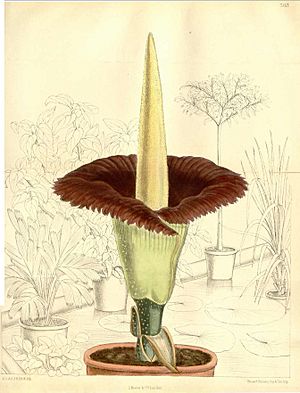Matilda Smith facts for kids
Matilda Smith (1854–1926) was a talented botanical artist. She drew plants for Curtis's Botanical Magazine for more than 40 years. She was the first artist to draw many plants from New Zealand. Matilda was also the first official artist for the Royal Botanic Gardens at Kew. She was only the second woman to become a member of the Linnaean Society.
Contents
Matilda Smith's Life Story

Matilda Smith was born in Bombay, India, on July 30, 1854. Her family moved to England when she was very young.
Her interest in plants and drawing them was encouraged by her second cousin, Joseph Dalton Hooker. He was the director of Kew Gardens. Hooker was also a skilled artist himself. He invited Matilda to Kew Gardens to train as an illustrator.
Becoming a Botanical Artist
Matilda admired the work of Walter Hood Fitch. He was the main artist for Curtis's Botanical Magazine at the time. Even though Matilda had little art training, Hooker encouraged her to show her drawings to the magazine. In 1878, they published one of her first drawings.
Fitch left the magazine in 1877 after a disagreement with Hooker. This meant Matilda quickly became a very important artist for the magazine. At first, she worked with Harriet Anne Thiselton-Dyer. Between 1879 and 1881, each issue had about 20 of Matilda's drawings. By 1887, she was almost the only artist for the magazine. In 1898, she became the magazine's official sole artist.
Over 40 years, from 1878 to 1923, Matilda drew more than 2,300 pictures for the magazine. This was only 600 fewer than Fitch had drawn. However, she did not get as much praise for her work during her lifetime. Some people, like art teacher Wilfrid Jasper Walter Blunt, did not fully appreciate her skills. But others, both then and now, admired her clear and precise drawings. Her long career at Kew Gardens shows how valuable her skills were.
Contributions to Kew Gardens
During her time at Kew Gardens, Matilda created 1,500 drawings for Icones Plantarum. This was a huge project to record all the plants at Kew. Hooker was editing this project. Matilda became the only artist for this series starting from Plate 1354. She was given money to continue this work for as long as she wanted.
She also redrew missing pictures for old books in Kew's library. Matilda was the first artist to draw many plants from New Zealand in detail. She was especially good at drawing plants from dried, flat, or imperfect samples.
Because of her amazing work, she was named the first official botanical artist of Kew Gardens in 1898. In 1921, the year she retired, she became a member of the Linnaean Society. She was only the second woman to receive this honor. She also won the Silver Veitch Memorial Medal from the Royal Horticultural Society. This award was for her botanical drawings and her work for Curtis's Botanical Magazine.
Legacy and Recognition
Two plant groups were named after her: Smithiantha (a type of plant in the Gesneriaceae family) and Smithiella (which is now known as Pilea myriantha). The Kew Guild also gives out the Matilda Smith Memorial Prize. This award goes to the best student in practical studies.
Matilda Smith passed away on December 29, 1926, in Kew, England. She is buried in Richmond Cemetery.
See also
 In Spanish: Matilda Smith para niños
In Spanish: Matilda Smith para niños


